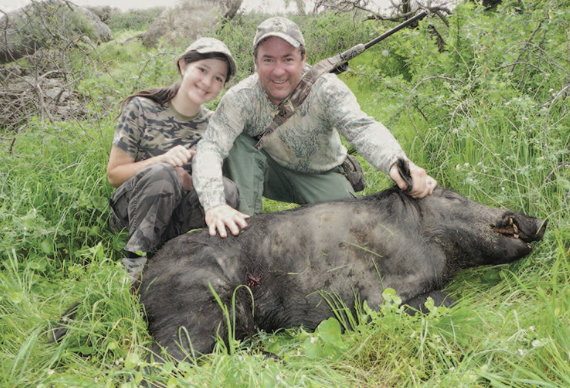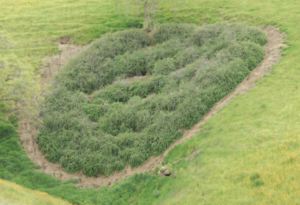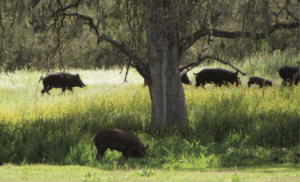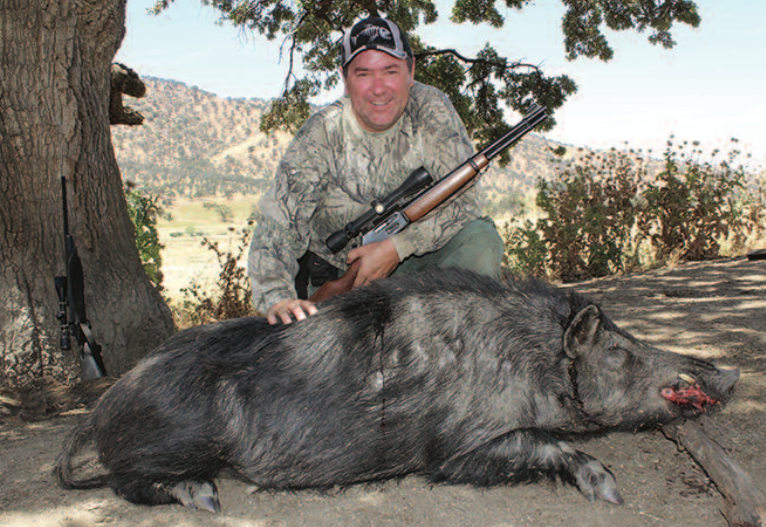
BY TIM E. HOVEY
We hiked through the oak grove before sunup, with Dwayne the pig hunting guide leading the way. As we made our way through the trees, I spotted a field of green in the shallow valley below. From our pace and direction, it was clear to me that we were headed to the cultivated plot. On the drive out, Dwayne had mentioned that farmers in the area reported that wild pigs were decimating their crops at night. Dwayne had scouted the area and knew the pigs would gorge themselves on barley and other food crops and then make their escape to the hills before sunrise. We were there to intercept them.
At the bottom of the hill, we found ourselves hiking an old two-track road that bordered the fenced field of green. The morning was dead quite except for the sound of large animals moving through the green leafy food plot. Dwayne excitedly pointed as a group pigs started exiting the field headed for the hills. I mounted the 30-30 rifle and found the pigs in the scope. A whistle from behind me stopped the group in their tracks. My shaky crosshairs found the largest target and I squeezed off a shot, a clean miss. At the report, the herd scattered, heading in all directions. A large sow cut in front of me and headed straight away uphill. I put the crosshairs on the pig’s head and squeezed off shot number two. The pig squealed once, tumbled to a stop and started rolling back downhill. My first big game animal was on the ground.
This hunt occurred about 25 years ago and is memorable for two reasons — it was the last time I ever hired a hunting guide, and it began my absolute obsession with hunting wild pigs in California.
Taking what I learned from that first hunt, I began to develop an eye for pig habitat and presence of wild pigs is not tough to see.
Feeding pigs will often root up acres of field in a single evening looking for anything beneath the ground that may be edible. Besides having an amazing sense of smell, wild pigs have an exceptional long and strong nose, perfectly suitable for tearing up a dozen inches of topsoil to find food. This destructive habit often puts them on the most wanted list with most farmers. Finding these areas of disturbance and determining how fresh they are will indicate that pigs have moved through the area.

Finding feeding areas is a good start, however, depending on the freshness of this sign, the feeding site could be weeks, if not months old. Once I know pigs are active nearby, I start to search for what I call a pig bed.
Pig beds are usually thick brush where pigs can access, bed down and feel safe from predators. These areas can sometimes be tough to locate, but once you know what to look for, a bed that is being frequently used can be the best way to locate animals.
Pig beds are usually located close to food and water. If you locate a water source, check for pig tracks in the fresh mud around the water. Pigs will often tack the same trail or path from their bed to the water. Look for a general direction of approach and start following it. If you find a patch of thick brush surrounded by churned up dirt, you’ve located a pig bed. Sometimes these resting areas will have several entrances and exits into the thick brush. As the pigs search for these pathways, they will create a dirt border around the bed, giving a hunter a great indicator of pig presence. Determining the freshness of these tracks or the occasional scat will tell you if anyone is currently home.

Pig movement usually depends on temperature and hunting pressure. Heavily pressured pigs will choose to become somewhat nocturnal, moving from their bed to feeding areas and back during the dark of night. During the hotter summer months, they will maintain this same pattern of movement, waiting out the heat of the day in their protected beds.
Two more great indicators of pig presence are wallows and rubs. Wallows are areas usually located near a water source where pigs will roll in mud and water to combat parasites and to help with body temperature insulation. These muddy holes are not tough to find and usually are covered in pig tracks and hair imprints if recently used.
Rubs are located on trees or boulders and are used by pigs to scratch or rub their bodies on. They are usually no more than 2.5 to 3 feet high and usually covered in dried mud. As evident by severely worn tree bases, some of these rub trees will be used for years by pigs traveling in the area.
If I locate all these signs within a square mile area, I will consider it occupied by pigs and I’ll start planning my hunting approach. Keeping the wind in my favor to combat their keen sense of smell, I’ll quietly stalk to an overlook and glass for pig movement.
I’ve hunted all sorts of big game animals in the western states, but nothing gets me more excited than chasing wild pigs in the green hills of California. They are challenging, smart and tough to bring down. If you get a chance to hunt pigs, look for the clear and often abundant signs of presence and stay aware and ready. When you’re hiking around pig beds near a water source, things can happen fast.




